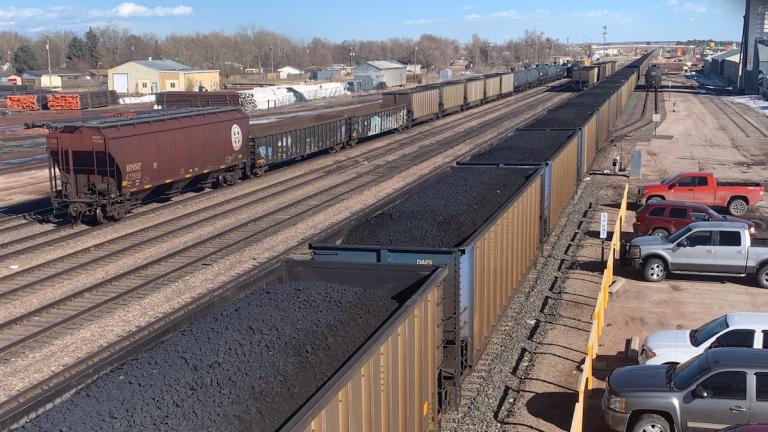
This story by ESI Journalism Fellow Dustin Bleizeffer was originally published for WyoFile, where it appears with additional photos and resources
__________
By Dustin Bleizeffer
Gillette and Campbell County appear to be bursting with economic activity despite a series of coal company bankruptcies, mine layoffs and a forecast for more of the same.
There have been fewer than 100 homes on the market in Campbell County for several months, and builders can’t find enough workers to meet soaring demand for new homes, locals report.
On any given weekend, the new Energy Capital Sports Complex is teeming with thousands of children, parents and onlookers taking in the excitement of youth football, baseball or soccer games — depending on the season. It’s also the future location for a new tournament-sized swimming pool.
Youth sports, local leaders say, is part of the community’s plan to bring in more outside revenue and help diversify the economy to prepare for a future with fewer mining jobs and lower coal revenue.
Gillette and Campbell County are best known as the epicenter of American coal, supplying about 40% of the nation’s coal for electrical generation.
But it’s also a destination for visitors from across the country and around the world.
“It’s a lot of people coming in here and staying at hotels, eating at restaurants — that kind of stuff,” Campbell County Commissioner Rusty Bell said. “When people come from around the state they say, ‘Well, how are you guys doing? They expect that we’re [struggling]. … Campbell County is growing.”
Cam-Plex, the county’s sprawling multi-event complex, continues to draw crowds throughout the year, hosting everything from theatre productions to horse-handling exhibitions, rodeos, vintage camper rallies and even international conventions such as the Pyrotechnics Guild International. Plans are underway to build a new outdoor amphitheater in anticipation of the International Pathfinders Camporee convention in 2024, which is expected to draw more than 50,000 attendees.
The county’s population is 46,300.
Gillette Mayor Louise Carter-King said she often hears the same reaction from people who come to town for sports tournaments and other events — they expect to see a struggling economy.
“We don’t have empty buildings in town,” Carter-King said. “When people come here they think Main Street is going to be empty but people are fighting to get buildings. I just sold my building downtown, and it’s just wonderful.”
Investing mineral wealth into sports and events facilities has not only helped Campbell county attract outside dollars, it also plays to the community’s deeply ingrained sports culture.
Such bets are far from a sure thing, however. They can work against local government budgets if the facilities come with a large amount of debt or present a major maintenance cost, said Kristin Smith, researcher for the Montana-based nonprofit Headwaters Economics.
Nor are such investments likely to be enough on their own. Replacing the tax revenue base that coal has historically provided — accounting for more than half Campbell County’s assessed valuation — will require adding many different businesses and industries, Smith said. And doing that will require a state and regional effort.
“The scale of the transition, from a fiscal point of view, is beyond what any one community or county can handle,” Smith said. “There is not a single industry — sports and events or otherwise — that will be able to generate revenue like coal has for Campbell County.”
This is not lost on local leaders who say they’re collaborating on a still-developing multi-pronged strategy to diversify the economy. It includes helping the industrial service industry — built around decades of coal, oil and natural gas extraction — expand into manufacturing, Bell said. The community is also working to develop a new carbon technology sector it hopes will maintain some demand for local mines and add value to coal.
“We’re not just a coal town,” Bell said. “We’re trying to change that four-letter-word ‘coal’ into carbon. I know it sounds crazy, but make coal carbon neutral.”
Perhaps the most prominent impact on Wyoming of the changing climate is how it’s already changing lives and economies that have been tied to fossil fuel extraction for decades. As an energy supplier to the nation and the world, Wyoming and its residents are largely at the mercy of forces that drive fossil fuel policy elsewhere. That reality is forcing the state, and particularly communities like Campbell County, to think about ways they can diversify and play to their other strengths.
WyoFile visited with leaders in Campbell County to learn how a vision for a new economy is taking shape.
The haves and have nots
Some worry that the appearance of a bustling economy in Gillette and Campbell County obscures underlying economic vulnerabilities and long-standing inequities.
The growing sports and events sector draws a lot of people from out of town who spend money at restaurants and hotels, and the facilities add to the quality of life for locals, Council of Community Services Executive Director Mikel Scott said. “But they’re mostly supporting service jobs.
“You would assume, then, that those essential workers would start to make more money,” Scott said. “But they don’t. And housing costs keep going up while wages stay the same, and access to health care and mental health care get cut.”
Cuts to mental health and substance abuse programs forced the closure of the Greenhouse this summer in Gillette, a supervised group home for those experiencing severe mental illness and homelessness. Before the pandemic hit, community service programs were already experiencing a withdrawal of support from coal companies, which had long been bulwark community partners.
Though federal pandemic relief funds have helped fill a gap in needs, Scott said she worries about what will happen when that support runs out.
“People are still going to need help with rent, utility payments and help with medical, dental — things like that,” Scott said. “We’re all really nervous about what that’s going to look like for us and for the low-income folks in town.”
The most reliable bellwether for what that future might look like, for now, remains coal and oil production.
Economic indicators
Powder River Basin mines produced 230 million tons of coal in 2020 compared to 496 million tons in 2008, according to the Energy Information Administration. So far this year coal production is up about 20%, and oil is enjoying a modest rebound from 2020.
However, Arch Resources — which changed its name from Arch Coal in 2020 — plans to close two coal mines in the county, the first, Coal Creek, in 2022. No closure date has been set for Black Thunder.
Together, the two mines employ 1,070 miners, according to Mine Safety and Health Administration data. Coal Creek produced 2.1 million tons of coal in 2020, while Black Thunder produced 50 million tons.
Industry researchers say several other mining companies in the Powder River Basin remain vulnerable to bankruptcy and that the industry is in permanent decline.






